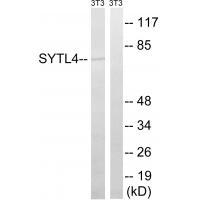
| WB | 咨询技术 | Human,Mouse,Rat |
| IF | 咨询技术 | Human,Mouse,Rat |
| IHC | 咨询技术 | Human,Mouse,Rat |
| ICC | 技术咨询 | Human,Mouse,Rat |
| FCM | 咨询技术 | Human,Mouse,Rat |
| Elisa | 咨询技术 | Human,Mouse,Rat |
| Aliases | exophilin-2; granuphilin; granuphilin-a; synaptotagmin-like protein 4; |
| Entrez GeneID | 94121; |
| WB Predicted band size | 76kDa |
| Host/Isotype | Rabbit IgG |
| Antibody Type | Primary antibody |
| Storage | Store at 4°C short term. Aliquot and store at -20°C long term. Avoid freeze/thaw cycles. |
| Species Reactivity | Human,Mouse |
| Immunogen | Synthesized peptide derived from internal of human SYTL4. |
| Formulation | Purified antibody in PBS with 0.05% sodium azide. |
+ +
以下是关于SYTL4抗体的参考文献示例(注:以下内容为示例性概括,实际文献需根据具体研究检索确认):
---
1. **文献名称**: "SYTL4 regulates vesicular transport in pancreatic cancer cells"
**作者**: Wang et al.
**摘要**: 研究通过SYTL4抗体进行Western blot和免疫荧光实验,揭示SYTL4在胰腺癌细胞囊泡运输中的关键作用,并发现其表达水平与肿瘤转移相关。
2. **文献名称**: "Identification of SYTL4 as a biomarker in ovarian carcinoma"
**作者**: Garcia-Rodriguez et al.
**摘要**: 利用SYTL4抗体对卵巢癌组织进行免疫组化分析,发现SYTL4高表达与患者化疗耐药性显著相关,提示其作为潜在预后标志物。
3. **文献名称**: "SYTL4 modulates synaptic exocytosis in neuronal cells"
**作者**: Chen et al.
**摘要**: 通过SYTL4特异性抗体检测神经元细胞中蛋白定位,证实SYTL4参与突触前膜囊泡释放,影响神经递质传递效率。
4. **文献名称**: "Proteomic analysis of SYTL4 interaction networks in macrophages"
**作者**: Kim et al.
**摘要**: 采用SYTL4抗体进行免疫共沉淀(Co-IP),鉴定出SYTL4在巨噬细胞中与多个分泌相关蛋白相互作用,可能调控炎症因子的释放。
---
建议通过PubMed或Google Scholar以“SYTL4 antibody”或“SYTL4 protein function”为关键词检索最新文献以获取准确信息。
The SYTL4 antibody targets the SYT-like protein 4 (SYTL4), also known as granuphilin or synaptotagmin-like protein 4. encoded by the *SYTL4* gene in humans. SYTL4 is a member of the synaptotagmin-like protein (Slp) family, characterized by a conserved N-terminal Rab-binding domain and C-terminal tandem C2 domains. It plays a critical role in regulating exocytosis, particularly in secretory cells such as pancreatic β-cells and neurons. SYTL4 interacts with Rab27A, a small GTPase involved in vesicle trafficking, to tether secretory granules to the plasma membrane, thereby modulating insulin secretion and neurotransmitter release. It also acts as a suppressor of exocytosis by binding to the SNARE complex component syntaxin, fine-tuning the release process.
Research on SYTL4 has highlighted its dual regulatory roles: promoting vesicle docking while inhibiting premature fusion, making it essential for maintaining secretory homeostasis. Dysregulation of SYTL4 is linked to diseases like diabetes, neurodegenerative disorders, and endocrine dysfunction. Antibodies against SYTL4 are widely used in molecular and cellular studies to investigate secretory mechanisms, vesicle dynamics, and disease pathology. Common applications include Western blotting, immunofluorescence, and immunoprecipitation to assess SYTL4 expression, localization, and interaction partners. These tools have advanced understanding of exocytosis pathways and potential therapeutic targets for secretory-related diseases.
×